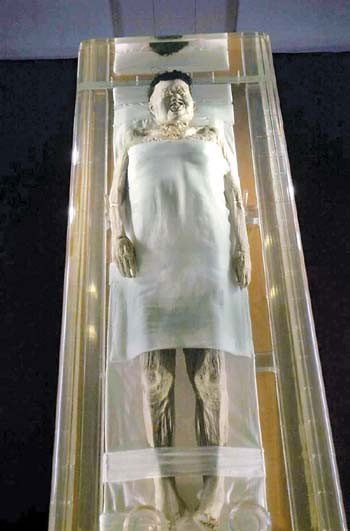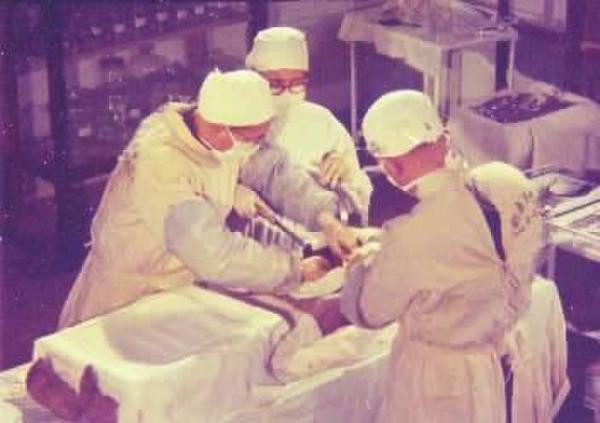She has slept peacefully for over 2,000 years. Yet strangely, through all this time, the beauty’s face, skin, and hair remain intact. What secrets does this famous Chinese “beauty” mummy conceal?
>>> Gallery: The 2,000-Year-Old “Sleeping” Beauty Mummy
The exhibition “The Essence of the Han Dynasty Mawangdui Ancient Artifacts” was held on April 28, 2011. This exhibition was jointly organized by the Shanxi Museum and the Hunan Provincial Museum. A total of more than 120 rare artifacts were introduced to the public for the first time. Among them, the mummy of Lady Xinzhui, a millennium-old uncorrupted remains, drew special attention from future generations.

Visitors express delight at viewing this extraordinary mummy.
In 1972, this unusual mummy was discovered on the outskirts of Changsha city, Hunan province, China. The “beauty” in the tomb remained quite well-preserved after all these years. She was identified as Lady Xinzhui, who died at the age of 50.
Lady Xinzhui was the wife of a Han dynasty marquis named Li Cang, who passed away in 163 B.C. She lived a luxurious life, evidenced by the lavish items found in her tomb, which included hundreds of intricately embroidered silk garments, elegant dresses, gloves, silk bags containing various spices, flowers and fragrant herbs, cosmetic boxes, over 100 lacquered items, musical instruments, and even food, along with more than 1,000 other objects.
“These items indicate that Lady Xinzhui lived a life of luxury and indulgence,” said Willow Weilan Hai Chang, director of the China Institute Gallery in New York, which exhibited some artifacts from her tomb in 2009. “She wanted to maintain such a lifestyle in the afterlife.”
As a beauty in her youth, Lady Xinzhui enjoyed culinary pleasures until her figure became plump due to obesity. Paintings in the tomb depict her using a cane for support. The woman likely had difficulty walking due to coronary thrombosis and atherosclerosis caused by her sedentary lifestyle. Examination results also revealed fused vertebrae, leading to severe back pain and mobility challenges. Lady Xinzhui also suffered from several parasitic diseases, likely due to consuming undercooked food or poor hygiene. Additionally, she suffered from blockages, heart disease, osteoporosis, and gallstones that caused bile duct obstruction.
What astonishes archaeologists the most is the vividness displayed on the face and body of this mummy. Features such as her eyes, nose, and mouth remain remarkably clear; her hair is smooth and shiny, her skin is soft and moist, and her limbs exhibit elasticity, with even the joints still able to move.
After conducting an autopsy, experts also revealed that the internal organs of this “beauty” are still relatively intact. Over 100 melon seeds were “present” in the stomach and small intestine of the mummy.

Close-up of the mummy of Lady Xinzhui.
The cause of death and the mummification method remain significant questions for scientists. It is known that Lady Xinzhui’s body was wrapped in more than 20 layers of silk, soaked in a “longevity potion”, and placed in four coffins. Around her tomb, there were five tons of charcoal, and this burial chamber is buried over 15 meters underground.

Experts conducting an autopsy on the mummy.
Professor and Dr. La Huo Gang – Director of the Ancient Cultural Heritage Protection Center at the Mawangdui Tomb of the Han Dynasty, Central South University, stated that the red solution found in Lady Xinzhui’s coffin is a mixture of various substances, including arsenic, cinnabar, mercury, and even several traditional Chinese medicines. It is this combination that created such a deep red solution. Scientists believe that this solution has preserved Lady Xinzhui’s body for over 2,000 years, having both antibacterial properties and excellent preservation capabilities.
According to Professor La, the preservation of Lady Xinzhui’s mummy for over 2,000 years is “full of randomness.” In addition to anti-decay methods, the dry environment favorable for preserving the body, and the sealed coffin preventing external bacteria from entering are also reasons why this “beauty”‘s remains have remained intact. Furthermore, the Mawangdui tomb has never been robbed. In other words, the geological conditions and human factors combined to create this miracle.
To help future generations recognize the beauty of this mysterious woman, scientists have reconstructed her image as she appeared in life. Indeed, according to the images recreated by experts, “Lady Xinzhui” deserves to be regarded as a beauty of the Han Dynasty.


















































